Structural Evolution of the Yuntai Mountain Area in Hunan Province: Implications for Sb-Au Exploration
Abstract
1. Introduction
2. Geological Background
2.1. Regional Geology
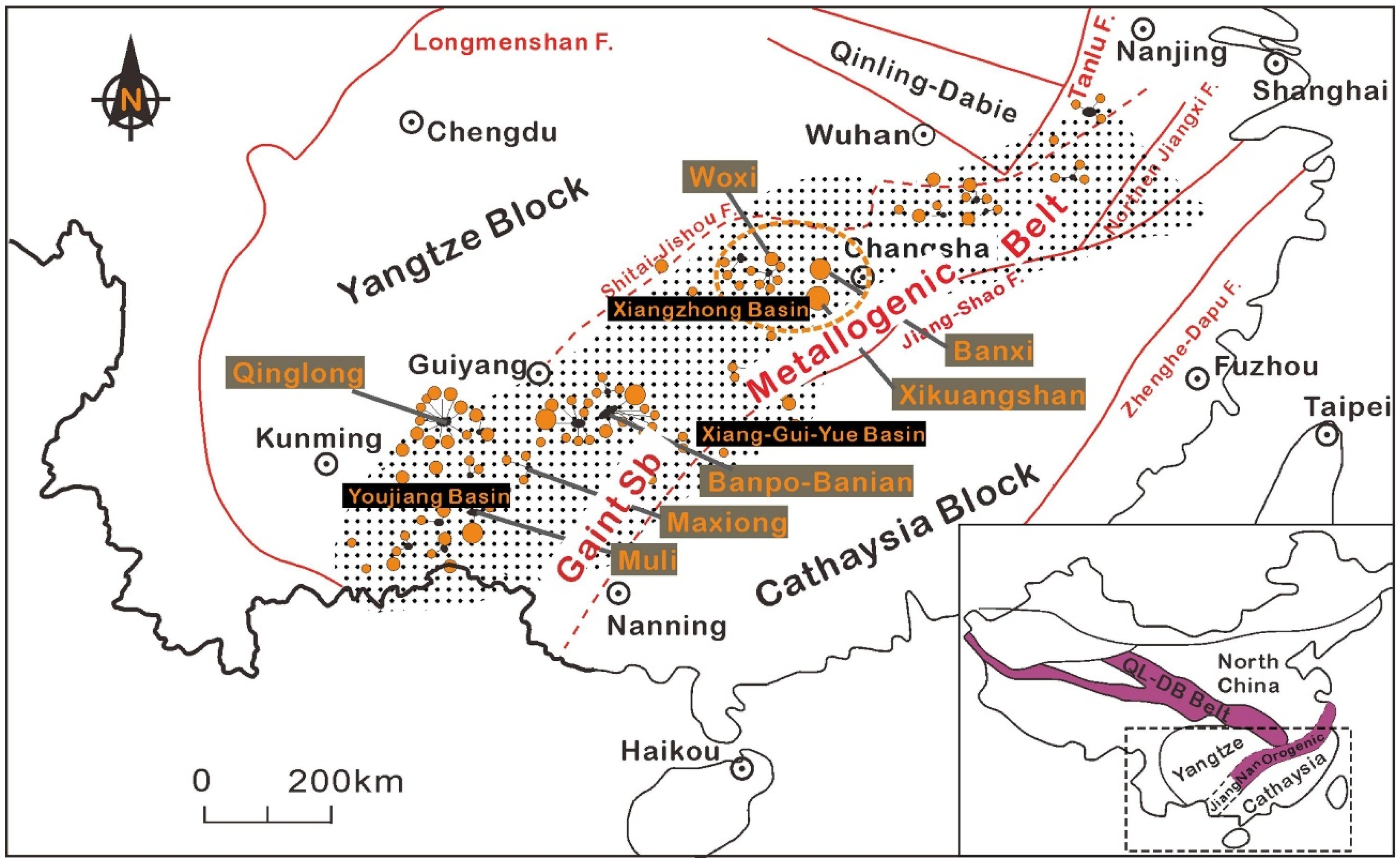

2.2. Local Geology
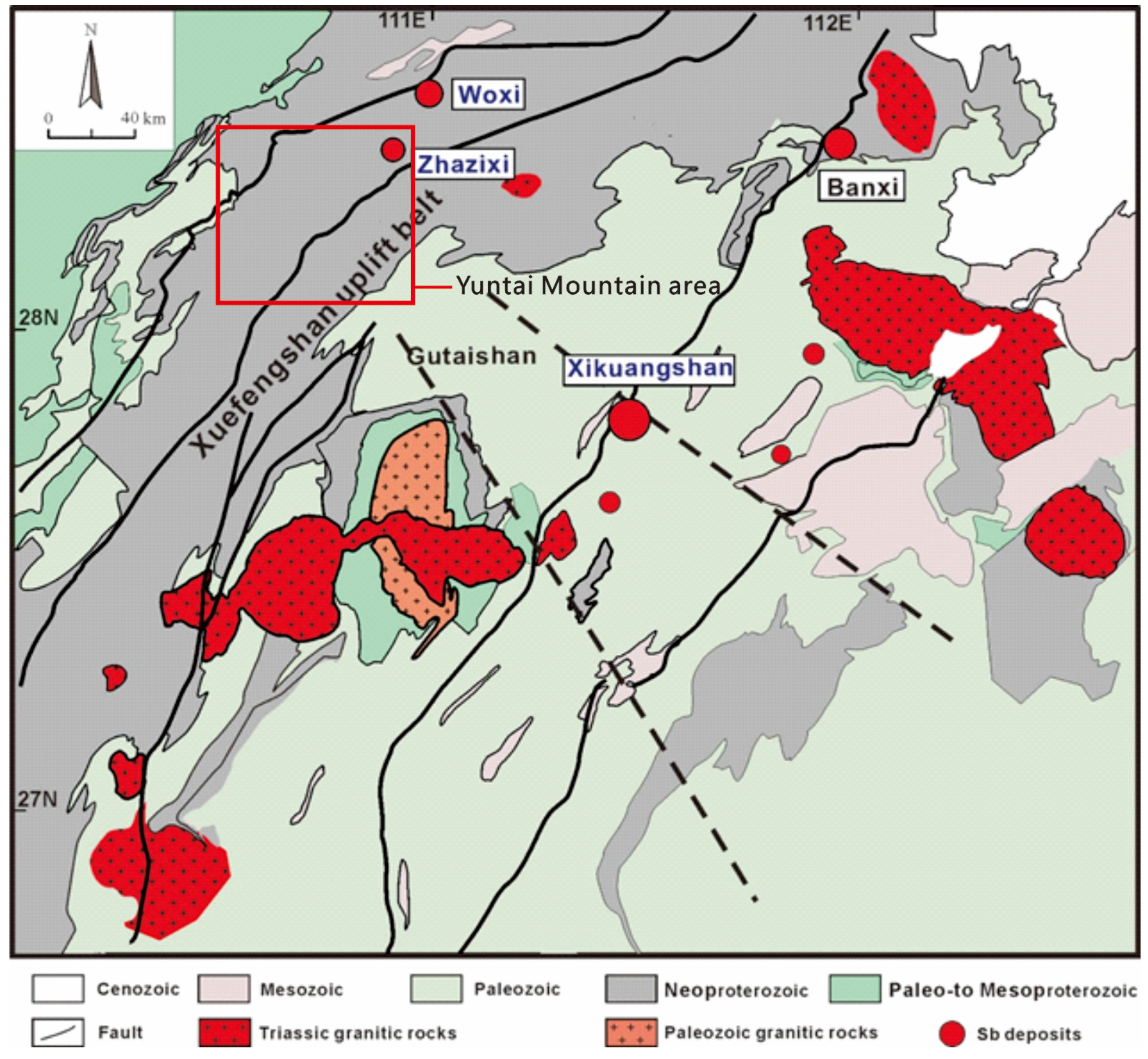
3. Materials and Methods
4. Results and Discussion
4.1. Analysis of Four Episodes of Tectonic Events
4.1.1. Early Paleozoic NW-SE Compression
4.1.2. Triassic NE-SW Compression
4.1.3. Jurassic NW-SE Compression
4.1.4. Cretaceous NW-SE Extension
4.2. Structural Characteristics of Strata and Mineral Veins
4.2.1. Strata
4.2.2. Ore Veins
4.3. Implications for Ore Exploration
4.4. Future Research Directions
- (a)
- Detailed geochemical and isotopic analysis could improve our understanding of ore-forming fluid sources and pathways. In addition, radiometric dating using U-Pb and Re-Os isotopic systems could be used to refine the timing of mineralization and correlate it with regional tectonic events.
- (b)
- The use of advanced geophysical methods, such as 3D seismic imaging and gravity inversion, can provide deeper insights into the subsurface structures controlling the metal flow and precipitation.
- (c)
- High-resolution remote sensing tools could enhance the detection of alteration zones associated with metal occurrences within the Yuntai Mountain area and delineate surface structural lineaments, allowing for more precise targeting of potential ore deposits.
5. Conclusions
- (a)
- The Yuntai Mountain area in Hunan Province has experienced a complex tectonic history, shaped by four major tectonic events: (1) Early Paleozoic NW-SE compression, (2) Triassic NE-SW compression, (3) Jurassic NW-SE compression, and (4) Cretaceous NW-SE extension. These tectonic episodes have played a pivotal role in controlling the structural evolution and mineralization processes in the region.
- (b)
- The NE-SW antimony veins demonstrate a clear association with the NW-SE compressional regimes of the Early Paleozoic and Jurassic periods, as well as the NW-SE extensional regime of the Cretaceous period. These multi-phase tectonic processes created favorable conditions (structural pathways and traps) for hydrothermal fluids activities, leading to the development of mineralized veins, which represent primary targets for future mineral prospecting in the study area.
- (c)
- The Triassic NE-SW compression significantly influenced the ore-bearing structures of the NW-SE antimony veins through oblique compressional forces. This compression not only reactivated pre-existing structures but also formed new fractures, which acted as conduits for hydrothermal solution migrations and subsequent metal deposition. Consequently, the NW-SE-oriented veins represent a secondary target for mineral prospecting.
- (d)
- The intersections of regional structures, such as faults, fractures, and foliation planes, emerge as critical sites for enhanced mineralization. These structural intersections serve as zones of increased permeability, promoting fluid mixing, pressure drops, and chemical reactions conducive to ore precipitation. The identification and detailed mapping of these intersections are, therefore, essential for delineating high-potential areas for mineral exploration.
- (e)
- The findings underscore the need for further investigations, including geochemical and geophysical studies, to refine exploration models. Particular attention should be given to areas where structural intersections coincide with favorable lithological units, as these locations host economically significant ore deposits.
Supplementary Materials
Author Contributions
Funding
Data Availability Statement
Acknowledgments
Conflicts of Interest
References
- Li, P.; Li, J.; Liu, X.; Li, C.; Huang, Z.; Zhou, F. Geochronology and source of the rare-metal pegmatite in the Mufushan area of the Jiangnan orogenic belt: A case study of the giant Renli Nb–Ta deposit in Hunan, China. Ore Geol. Rev. 2020, 116, 103237. [Google Scholar] [CrossRef]
- Zhao, L.; Guo, F.; Fan, W.; Zhang, Q.; Wu, Y.; Li, J.; Yan, W. Early Cretaceous potassic volcanic rocks in the Jiangnan Orogenic Belt, East China: Crustal melting in response to subduction of the Pacific–Izanagi ridge? Chem. Geol. 2016, 437, 30–43. [Google Scholar] [CrossRef]
- Xu, D.; Deng, T.; Chi, G.; Wang, Z.; Zou, F.; Zhang, J.; Zou, S. Gold mineralization in the Jiangnan Orogenic Belt of South China: Geological, geochemical and geochronological characteristics, ore deposit-type and geodynamic setting. Ore Geol. Rev. 2017, 88, 565–618. [Google Scholar] [CrossRef]
- Liang, Y.; Zheng, H.; He, Z.; De Grave, J.; Li, H.; Tang, Z.; Lash, G.G.; Kang, P. Reassessing early to mid-Neoproterozoic (∼885–720 Ma) tectonic evolution of the southwestern Jiangnan Orogen: A detrital zircon perspective. Precambrian Res. 2024, 410, 07482. [Google Scholar] [CrossRef]
- Wang, C.; Shao, Y.; Chen, X.; Zhang, X.; Li, H.; Wei, H.; Liu, Q. Genesis of the Jinji gold deposit in the Jiangnan Orogen, South China: Constraints from geology, chlorite geochemistry, age and HOS-Pb isotopes. Ore Geol. Rev. 2023, 155, 105352. [Google Scholar] [CrossRef]
- Wang, C.; Shao, Y.; Zhang, X.; Lai, C.; Liu, Z.; Li, H.; Chao, G.; Liu, Q. Metallogenesis of the Hengjiangchong gold deposit in Jiangnan orogen, South China. Ore Geol. Rev. 2020, 118, 103350. [Google Scholar] [CrossRef]
- Li, H.; Zhou, Z.K.; Algeo, T.J.; Wu, J.H.; Jiang, W.C. Geochronology and geochemistry of tuffaceous rocks from the Banxi Group: Implications for Neoproterozoic tectonic evolution of the southeastern Yangtze Block, South China. J. Asian Earth Sci. 2019, 177, 152–176. [Google Scholar] [CrossRef]
- Li, H.; Wu, Q.H.; Evans, N.J.; Zhou, Z.K.; Kong, H.; Xi, X.S.; Lin, Z.W. Geochemistry and geochronology of the Banxi Sb deposit: Implications for fluid origin and the evolution of Sb mineralization in central-western Hunan, South China. Gondwana Res. 2018, 55, 112–134. [Google Scholar] [CrossRef]
- Li, H.; Zhu, D.P.; Shen, L.W.; Algeo, T.J.; Elatikpo, S.M. A general ore formation model for metasediment-hosted Sb-(Au-W) mineralization of the Woxi and Banxi deposits in South China. Chem. Geol. 2022, 607, 121020. [Google Scholar] [CrossRef]
- Li, H.; Danišík, M.; Zhou, Z.K.; Jiang, W.C.; Wu, J.H. Integrated U–Pb, Lu–Hf and (U–Th)/He analysis of zircon from the Banxi Sb deposit and its implications for the low-temperature mineralization in South China. Geosci. Front. 2020, 11, 1323–1335. [Google Scholar] [CrossRef]
- Fu, S.; Zajacz, Z.; Tsay, A.; Hu, R. Can magma degassing at depth donate the metal budget of large hydrothermal Sb deposits? Geochim. Cosmochim. Acta 2020, 290, 1–15. [Google Scholar] [CrossRef]
- Fu, S.; Hu, R.; Batt, G.E.; Danišík, M.; Evans, N.J.; Mi, X. Zircon (U-Th)/He thermochronometric constraints on the mineralization of the giant Xikuangshan Sb deposit in central Hunan, South China. Miner. Depos. 2020, 55, 901–912. [Google Scholar] [CrossRef]
- Krinov, L. A review on the Mineralogy of Stibnite in Hydrothermal Gold Deposits. Acad. J. Earth Sci. 2024, 2, 16–20. [Google Scholar]
- Zhang, D.; Pan, J.; Gao, J.; Dai, T.; Bayless, R.C. In situ LA ICP-MS analysis of trace elements in scheelite from the Xuefeng Uplift Belt, South China and its metallogenic implications. Ore Geol. Rev. 2021, 133, 104097. [Google Scholar] [CrossRef]
- Zeng, G.P.; Gong, Y.J.; Hu, X.L.; Xiong, S.F. Geology, fluid inclusions, and geochemistry of the Zhazixi Sb–W deposit, Hunan, South China. Ore Geol. Rev. 2017, 91, 1025–1039. [Google Scholar] [CrossRef]
- Li, H.; Zhou, Z.K.; Evans, N.J.; Kong, H.; Wu, Q.H.; Xi, X.S. Fluid-zircon interaction during low-temperature hydrothermal processes: Implications for the genesis of the Banxi antimony deposit, South China. Ore Geol. Rev. 2019, 114, 103137. [Google Scholar] [CrossRef]
- Wang, T.; Fu, S.; Tang, Y.; Wei, L. Scheelite U–Pb dating constraints on the timing of the formation of the Zhazixi Sb-W deposit in South China. Miner. Depos. 2024, 59, 445–452. [Google Scholar] [CrossRef]
- Yao, J.; Cawood, P.A.; Shu, L.; Zhao, G. Jiangnan orogen, South China: A ~970–820 Ma Rodinia margin accretionary belt. Earth-Sci. Rev. 2019, 196, 102872. [Google Scholar] [CrossRef]
- Bai, D.; Li, B.; Zhou, C.; Sun, J.; Wei, F.; Zeng, G.; Jiang, W.; Li, Y.; Jiang, Q. Gold mineralization events of the Jiangnan Orogen in Hunan and their tectonic settings. Chin. J. Petromineral. 2021, 40, 897–922. [Google Scholar]
- Li, B.; Xu, D.; Bai, D.; Chi, G.; Dai, J.; Gao, C.; Deng, T.; Zou, S.; Ma, W.; Wang, G.; et al. Structural deformation, metallogenic epoch and genetic mechanism of the Woxi Au-Sb-W deposit, Western Hunan Province, South China. Sci. China Earth Sci. 2022, 65, 2358–2384. [Google Scholar] [CrossRef]
- Cawood, P.A.; Wang, Y.; Xu, Y.; Zhao, G. Locating South China in Rodinia and Gondwana: A fragment of greater India lith-osphere? Geology 2013, 41, 903–906. [Google Scholar] [CrossRef]
- Li, X.; Wang, C.; Hua, R.; Wei, X. Fluid origin and structural enhancement during mineralization of the Jinshan orogenic gold deposit, South China. Miner. Depos. 2010, 45, 583–597. [Google Scholar] [CrossRef]
- Wang, C.; Shao, Y.J.; Goldfarb, R.; Tan, S.M.; Sun, J.; Zhou, C.; Zheng, H.; Liu, Q.Q.; Xiong, Y.Q. Superimposed Gold Min-eralization Events in the Tuanshanbei Orogenic Gold Deposit, Central Jiangnan Orogen, South China. Econ. Geol. 2024, 119, 113–137. [Google Scholar] [CrossRef]
- Wang, Y.; Fan, W.; Zhang, G.; Zhang, Y. Phanerozoic tectonics of the South China Block: Key observations and controversies. Gondwana Res. 2013, 23, 1273–1305. [Google Scholar]
- Ni, P.; Wang, G.G.; Chen, H.; Xu, Y.F.; Guan, S.J.; Pan, J.Y.; Li, L. An Early Paleozoic orogenic gold belt along the Jiang− Shao Fault, south China: Evidence from fluid inclusions and Rb–Sr dating of quartz in the Huangshan and Pingshui deposits. J. Asian Earth Sci. 2015, 103, 87–102. [Google Scholar] [CrossRef]
- Yan, J.; Fu, S.; Liu, S.; Wei, L.; Wang, T. Giant Sb metallogenic belt in South China: A product of Late Mesozoic flat-slab subduction of paleo-Pacific plate. Ore Geol. Rev. 2022, 142, 104697. [Google Scholar] [CrossRef]
- Zhang, L.; Yang, L.Q.; Groves, D.I.; Sun, S.C.; Liu, Y.; Wang, J.Y.; Li, R.H.; Wu, S.G.; Gao, L.; Guo, J.L.; et al. An Overview of Timing and Structural Geometry of Gold, Gold-Antimony and Antimony Mineralization in the Jiangnan Orogen, Southern China. Ore Geol. Rev. 2019, 115, 103173. [Google Scholar] [CrossRef]
- Jia, L.; Li, H.; Wang, L.; Zhang, D. Geochemical Characteristics of Fluid Inclusions and Isotopes in Zhazixi Sb-W Deposit. Int. J. Heat Technol. 2022, 40, 405. [Google Scholar] [CrossRef]
- Hu, R.Z.; Chen, W.T.; Xu, D.R.; Zhou, M.F. Reviews and new metallogenic models of mineral deposits in South China: An introduction. J. Asian Earth Sci. 2017, 137, 1–8. [Google Scholar] [CrossRef]
- Angelier, J. Determination of the mean principal directions of stresses for a given fault population. Tectonophysics 1979, 56, T17–T26. [Google Scholar] [CrossRef]
- Vollmer, F.W. C program for automatic contouring of spherical orientation data using a modified Kamb method. Comput. Geosci. 1995, 21, 31–49. [Google Scholar] [CrossRef]
- Delvaux, D.; Sperner, B. Stress tensor inversion from fault kinematic indicators and focal mechanism data: The TENSOR program. In New Insights into Structural Interpretation and Modelling; Geological Society: London, UK, 2003; Volume 212, pp. 75–100. [Google Scholar]
- Atif, Y.; Soulaimani, A.; Ait Lahna, A.; Yaagoub, D.; Youbi, N.; Pour, A.B.; Hashim, M. Structural analysis and paleostress evolution in the Imiter silver mining region, Eastern Anti Atlas, Morocco: Implications for mineral exploration. Minerals 2022, 12, 1563. [Google Scholar] [CrossRef]
- Wang, B.; Li, H.; Sun, Z.; Quan, W.; Huang, Y.; Faisal, M. Yingde–Guangning Granitic Plutons Record Complex Tectonic Evolution During Paleozoic-Mesozoic: Implications for Gold Exploration in Western Guangdong, South China. Minerals 2024, 14, 1259. [Google Scholar] [CrossRef]
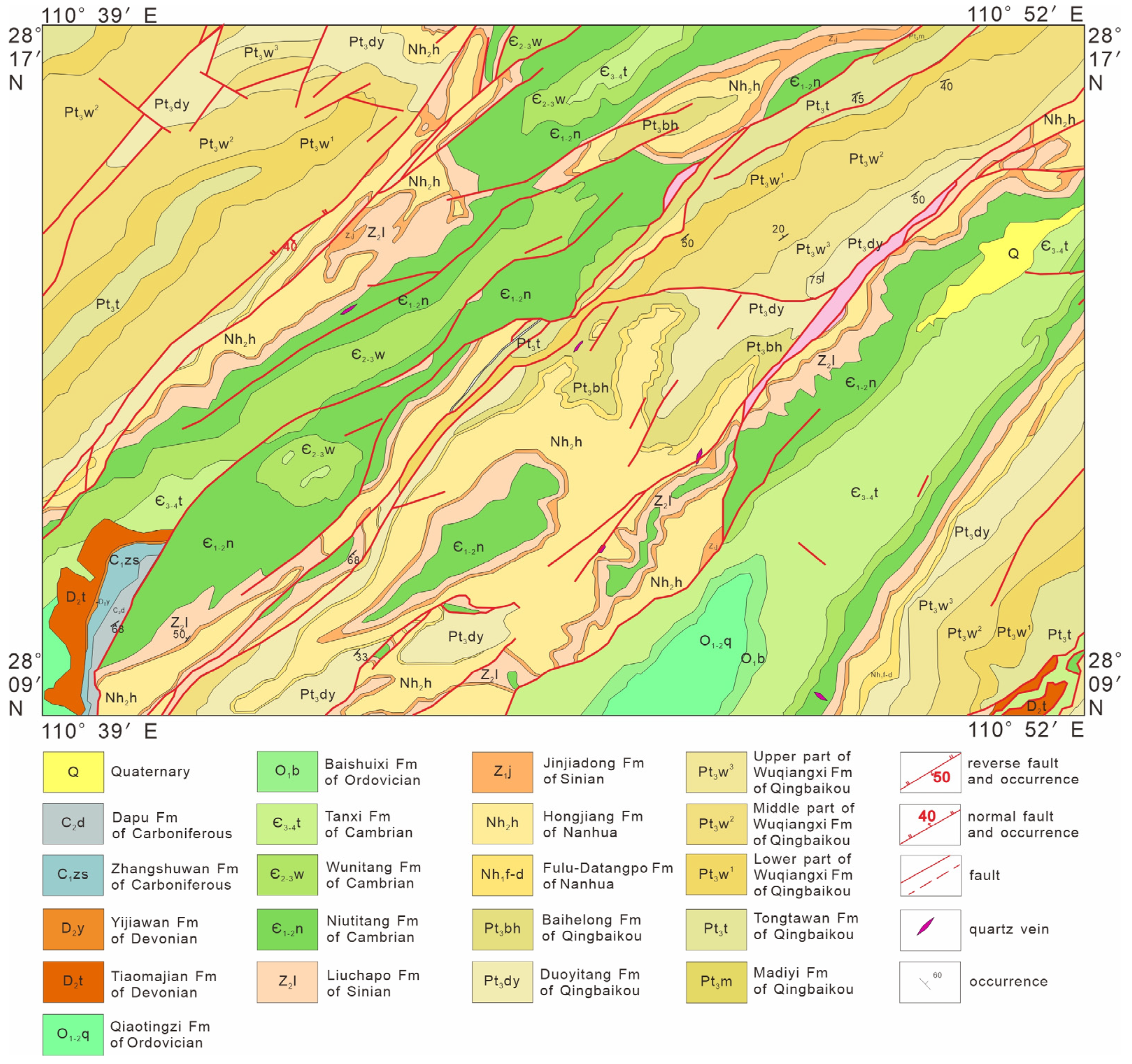
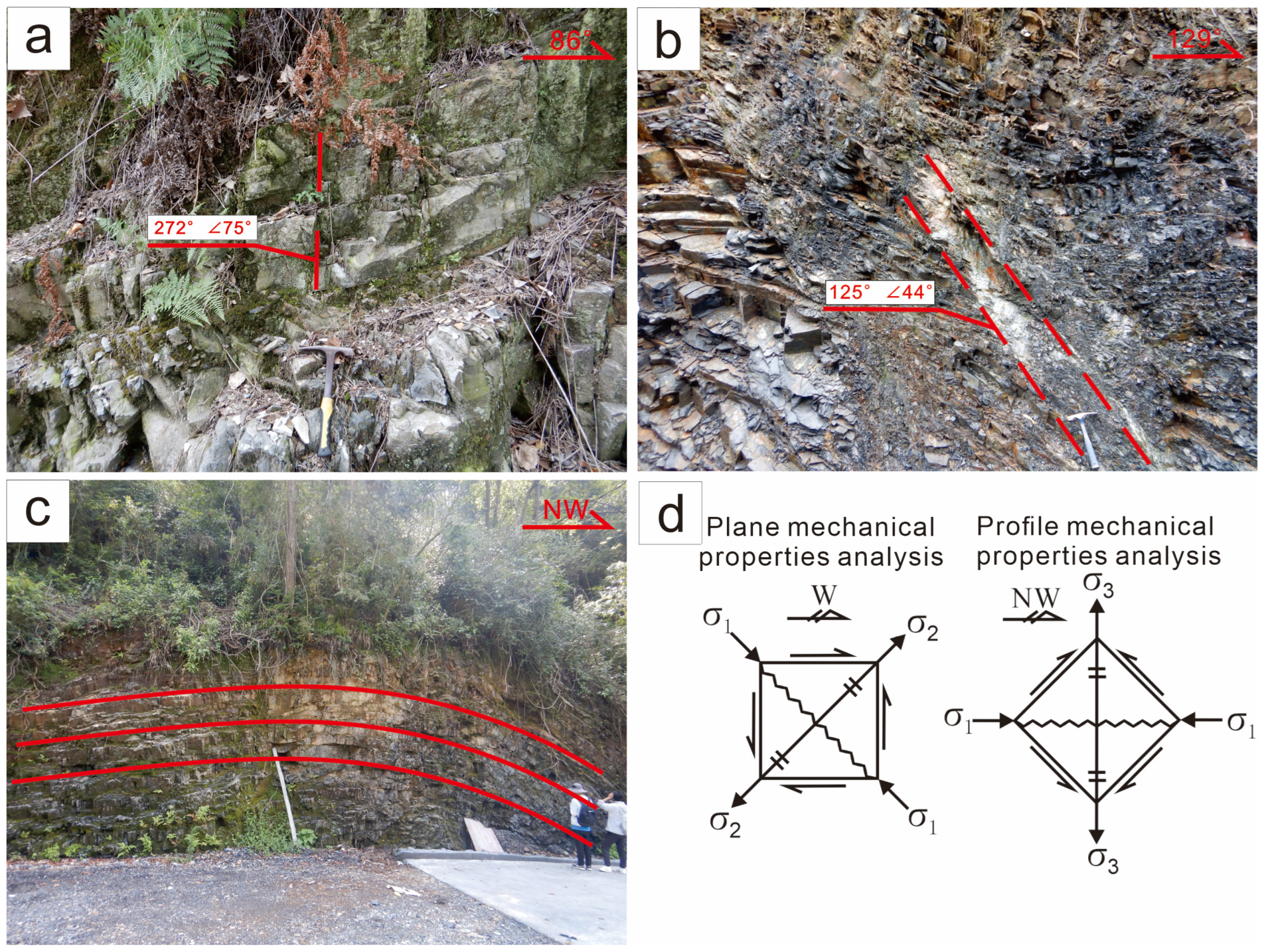

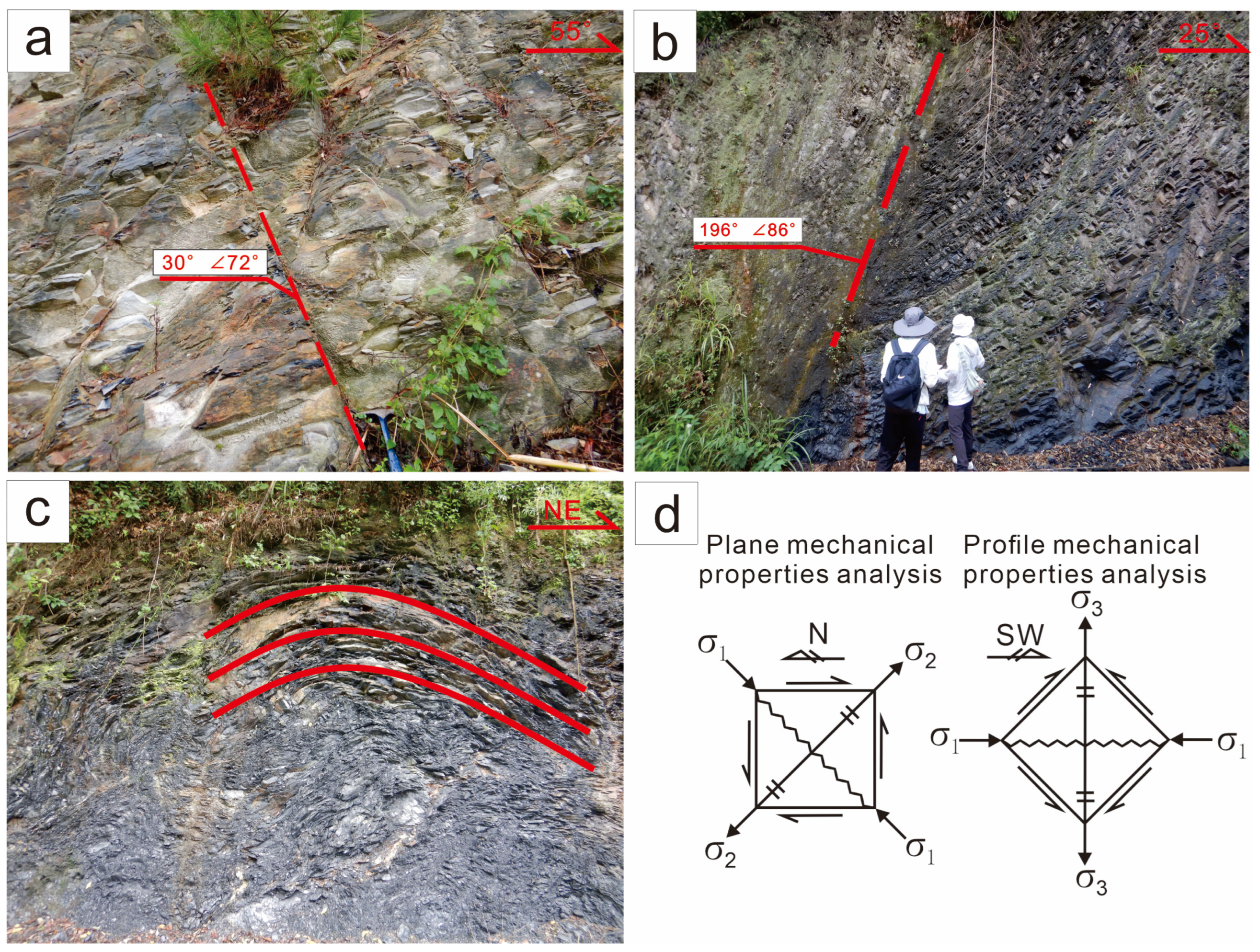

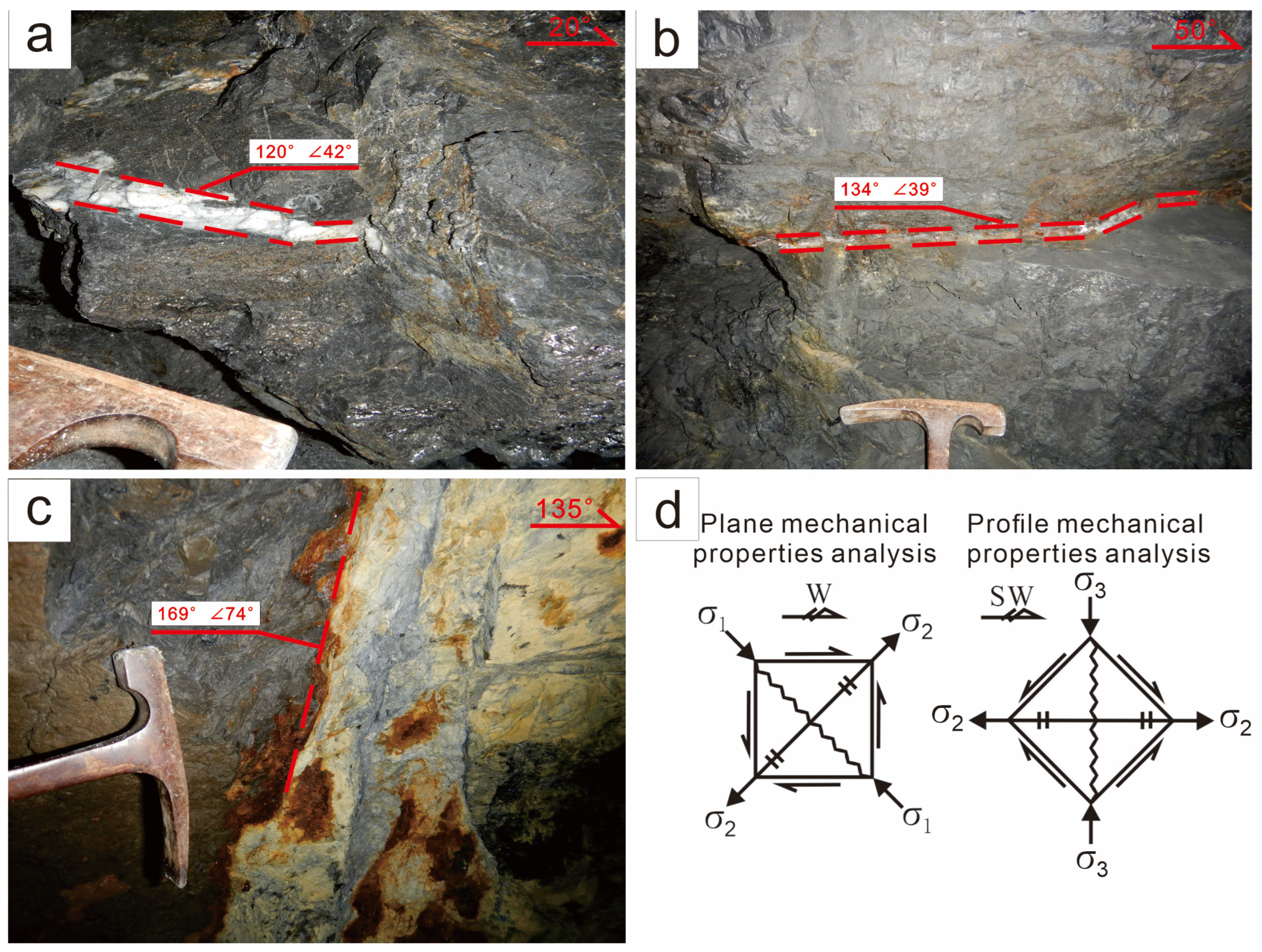
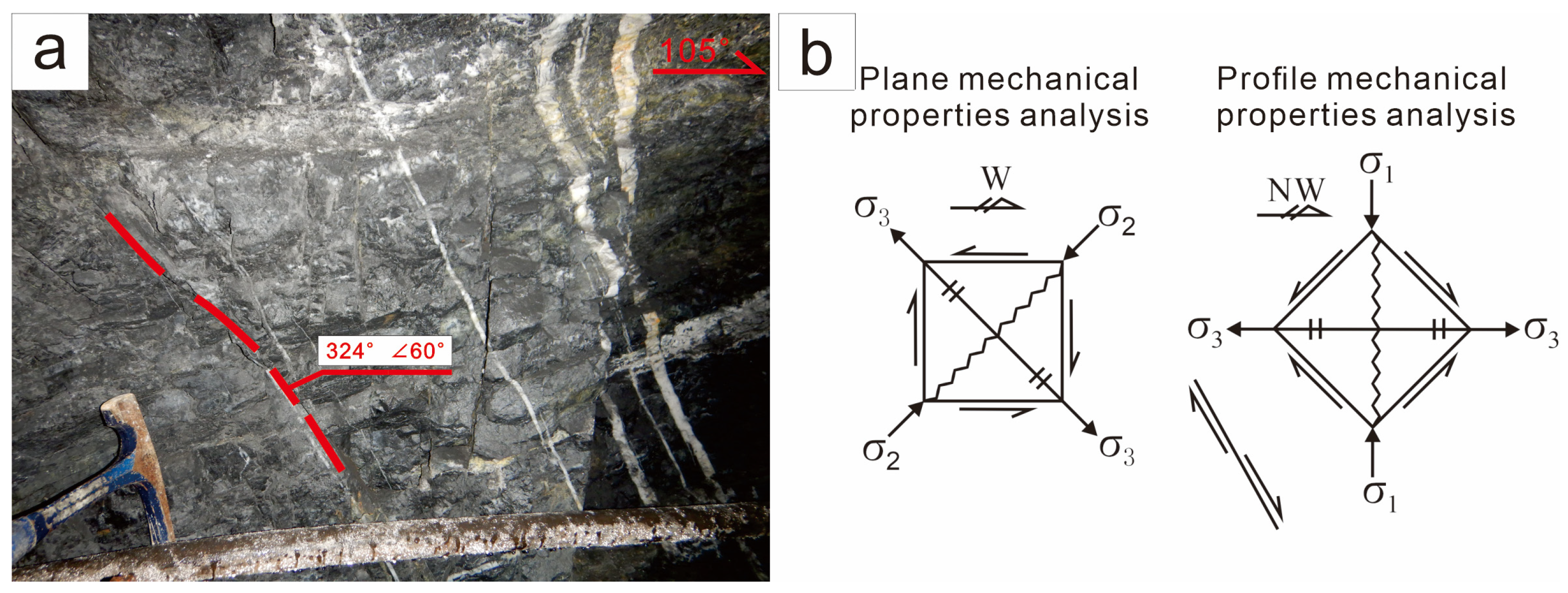
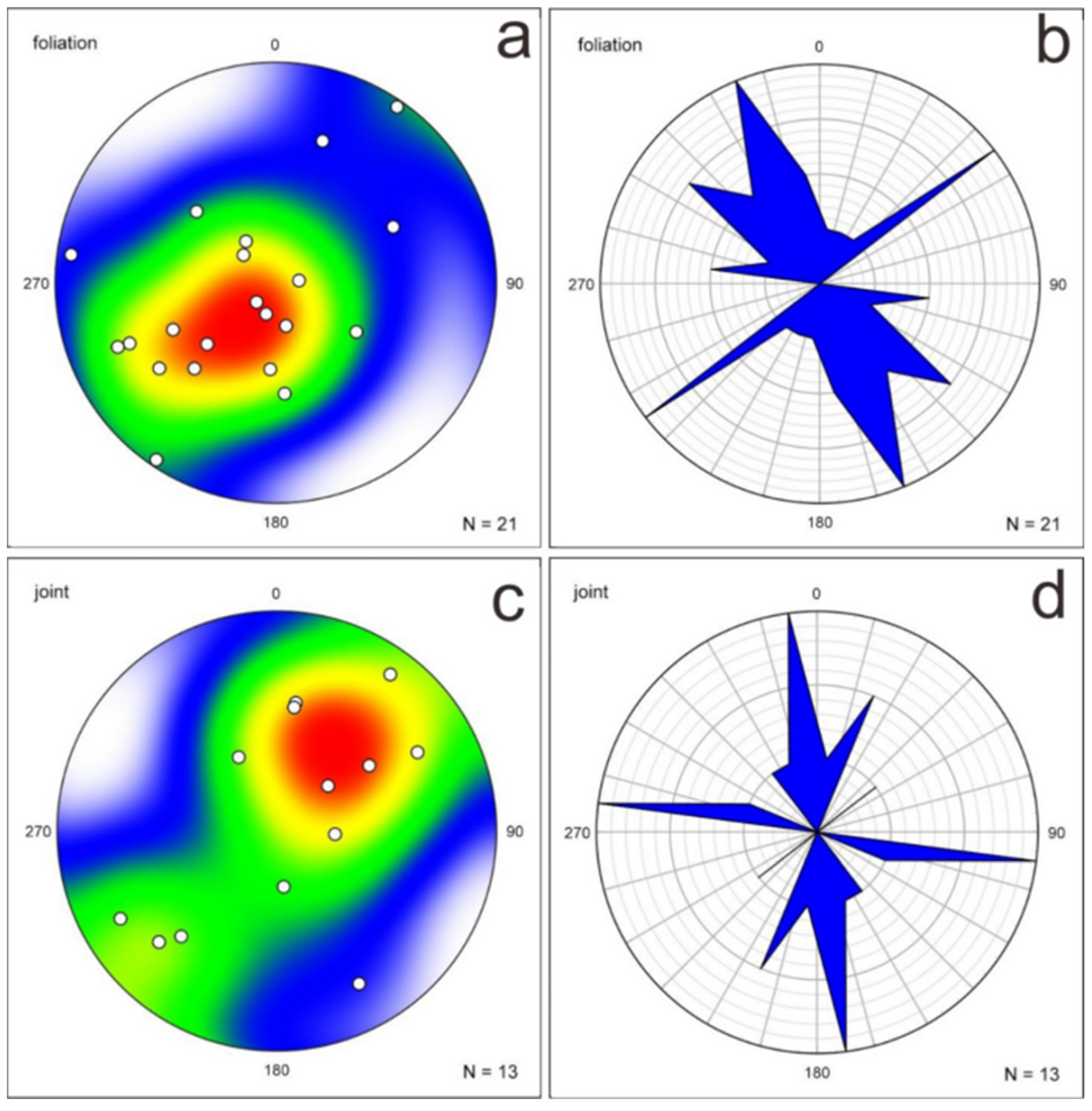

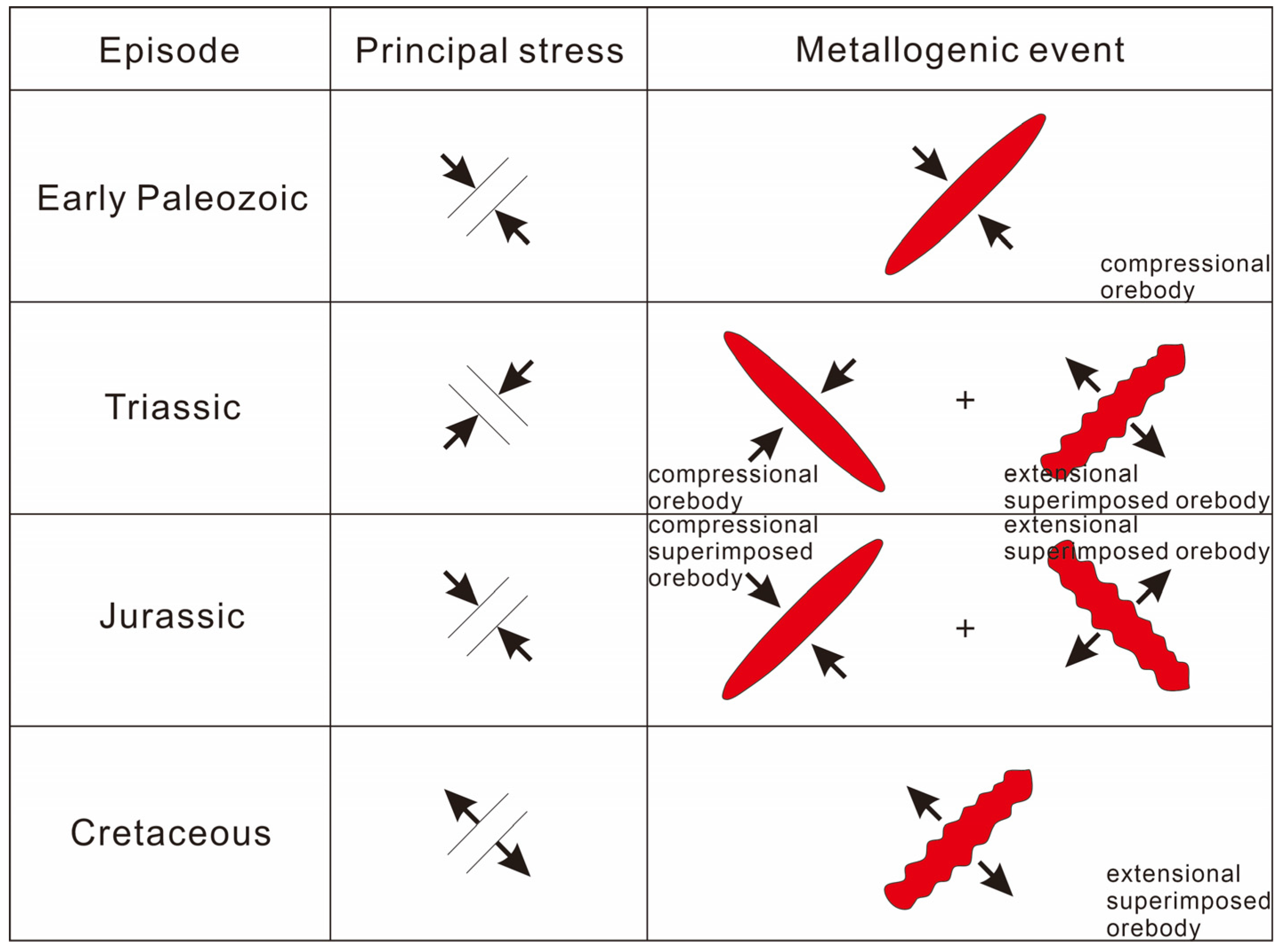
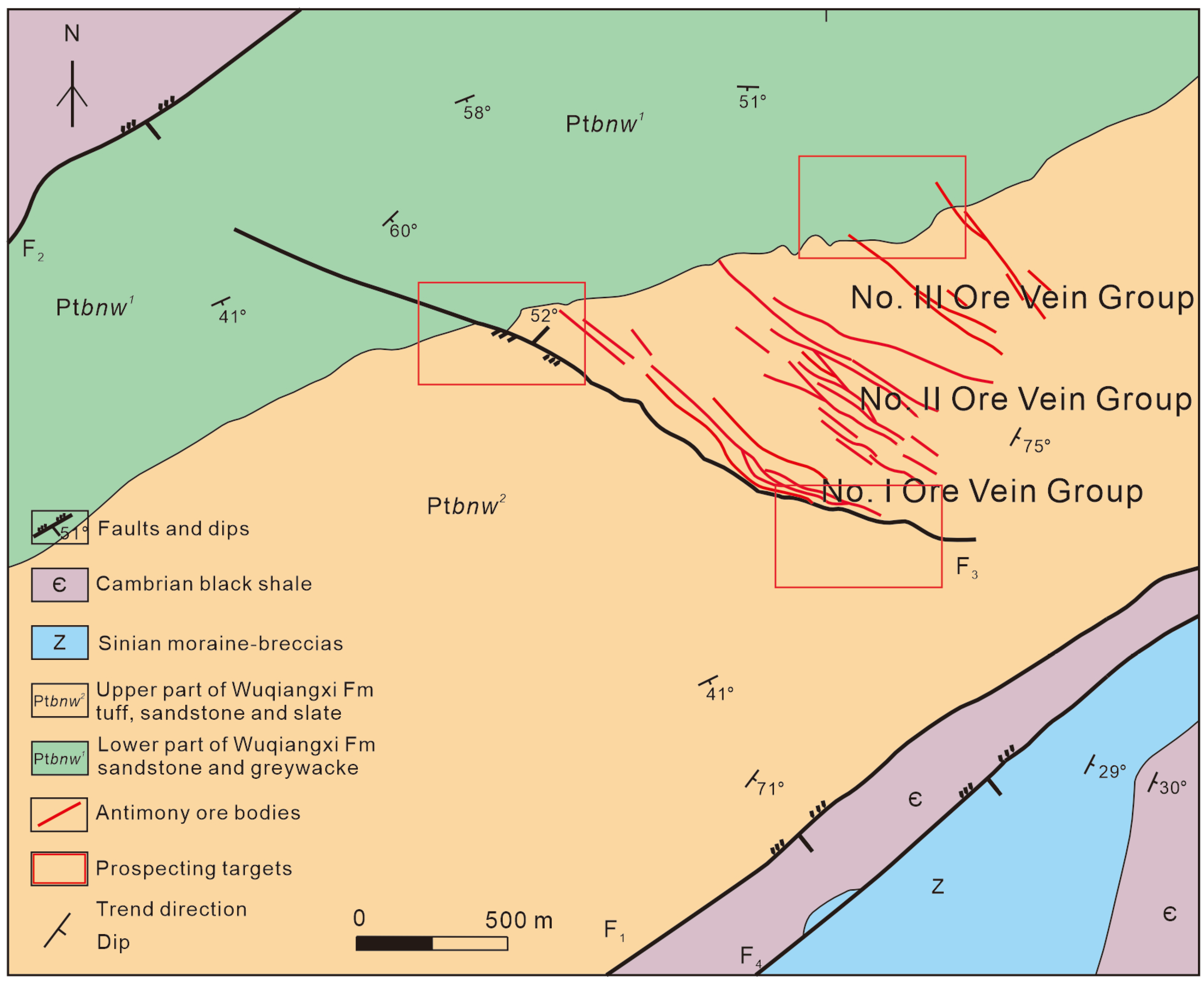
Disclaimer/Publisher’s Note: The statements, opinions and data contained in all publications are solely those of the individual author(s) and contributor(s) and not of MDPI and/or the editor(s). MDPI and/or the editor(s) disclaim responsibility for any injury to people or property resulting from any ideas, methods, instructions or products referred to in the content. |
© 2025 by the authors. Licensee MDPI, Basel, Switzerland. This article is an open access article distributed under the terms and conditions of the Creative Commons Attribution (CC BY) license (https://creativecommons.org/licenses/by/4.0/).
Share and Cite
Chen, S.; Li, H.; Zhang, J.; Wu, J.; Xu, J.; Zhang, Z.; Faisal, M. Structural Evolution of the Yuntai Mountain Area in Hunan Province: Implications for Sb-Au Exploration. Minerals 2025, 15, 452. https://doi.org/10.3390/min15050452
Chen S, Li H, Zhang J, Wu J, Xu J, Zhang Z, Faisal M. Structural Evolution of the Yuntai Mountain Area in Hunan Province: Implications for Sb-Au Exploration. Minerals. 2025; 15(5):452. https://doi.org/10.3390/min15050452
Chicago/Turabian StyleChen, Shumin, Huan Li, Junfeng Zhang, Jinhong Wu, Junjie Xu, Zhiming Zhang, and Mohamed Faisal. 2025. "Structural Evolution of the Yuntai Mountain Area in Hunan Province: Implications for Sb-Au Exploration" Minerals 15, no. 5: 452. https://doi.org/10.3390/min15050452
APA StyleChen, S., Li, H., Zhang, J., Wu, J., Xu, J., Zhang, Z., & Faisal, M. (2025). Structural Evolution of the Yuntai Mountain Area in Hunan Province: Implications for Sb-Au Exploration. Minerals, 15(5), 452. https://doi.org/10.3390/min15050452








